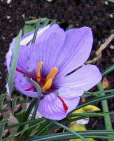 Native to an unknown place in the Mediterranean region, this cormous perennial belongs to the iris family, Iridaceae, that also includes gladiolus, crocosmia, and blue-eyed grass. It is sometimes called autumn crocus but that name is also used for a species of colchicum that is similar in appearance but poisonous. The plants grow up to 1′ tall and have basal linear grass-like leaves and fragrant, lavender, white, or purple cup-like flowers in the fall for 2-3 weeks, opening during the day and closing at night. The flowers are 1.5-2″ across and have 3 long style branches each with a reddish-orange stigmas that may protrude beyond the petal cup. These stigmas may be harvested, dried, and used as a spice, dye, or medicine, uses that go back at least 3,500 years. Since 75,000 plants are needed to produce a pound of saffron, the plants are usually grown in the garden strickly for their ornamental value. The genus name, Crocus, is from the Greek word κρόκος, krokos meaning thread and refers to the appearance of the stigmas. The specific epithet, sativus, is the classical Latin word meaning sown and refers to the fact that the plant is cultivated.
Native to an unknown place in the Mediterranean region, this cormous perennial belongs to the iris family, Iridaceae, that also includes gladiolus, crocosmia, and blue-eyed grass. It is sometimes called autumn crocus but that name is also used for a species of colchicum that is similar in appearance but poisonous. The plants grow up to 1′ tall and have basal linear grass-like leaves and fragrant, lavender, white, or purple cup-like flowers in the fall for 2-3 weeks, opening during the day and closing at night. The flowers are 1.5-2″ across and have 3 long style branches each with a reddish-orange stigmas that may protrude beyond the petal cup. These stigmas may be harvested, dried, and used as a spice, dye, or medicine, uses that go back at least 3,500 years. Since 75,000 plants are needed to produce a pound of saffron, the plants are usually grown in the garden strickly for their ornamental value. The genus name, Crocus, is from the Greek word κρόκος, krokos meaning thread and refers to the appearance of the stigmas. The specific epithet, sativus, is the classical Latin word meaning sown and refers to the fact that the plant is cultivated.
Type: Fall blooming cormous perennial
Bloom: Lavender, white, or purple 1½ -2” fragrant flowers with red stigmas are produced in September and October.
Foliage: Linear, grass-like leaves; lasts for 8-12 weeks
Size: 4-6 H x 4-6” W foliage
Light: Sun to bright light.
Soil: Moderately rich, light, well-drained.
Hardiness: Zones 6-8 in the South, 9 in the West.
Pests and Diseases: Nematodes, leaf rust, and corm rot may be problems.
Propagation: Division of cormlets.
Companion Plants: Cyclamen.
